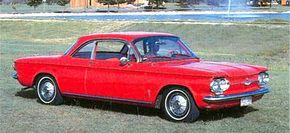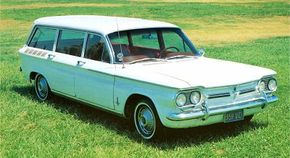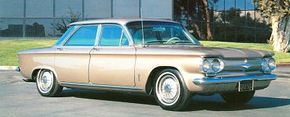It is often said that the 1960-1964 Chevrolet Corvair Monza started the sporty car boom in America. Many would argue that it began long before the Monza was even a gleam in Chevrolet's eye, giving the honor instead to early Corvettes, Thunderbirds, and Studebaker Hawks.
Advertisement
While certainly a valid argument, these were comparatively expensive vehicles, and the modern interpretation is that a "sporty car" leans toward the more affordable end of the price spectrum.
But whether a pioneer of the concept or simply a follower, it can be accurately said the Monza saved the Corvair -- and incidentally introduced the marketing ploy of sticking vinyl buckets and a floor-mounted shifter into a compact and calling it a sports car.
Ironically, the Monza is perhaps more noted for what it led to (the Mustang) than what it did for the Corvair. As it turned out, GM's unique rear-engine compact proved one of the corporation's major albatrosses; it was the subject of endless litigation, and played the lead villain in the book that launched Ralph Nader. (That book, Unsafe at Any Speed, conclusively proved that the inattentive should not drive early Corvairs.)
Though the 1960-1961 Corvairs could indeed be a bit tricky to handle, later models were much improved, and by 1965 the Corvair sported a superb suspension that made it one of the most imaginative, efficient, and progressive cars of the decade.
The first Monza arrived late in the 1960 model year as a "spring special" to shore up the Corvair's disappointing sales. Against the plug-ordinary Falcon and Rambler, and the unique-looking but technically mundane Plymouth Valiant, the Corvair was doing much poorer than expected.
Indeed, the Monza was barely on the market when GM Styling was hard at work on what would become the 1962 Chevy II, later the Chevy Nova -- a conventional compact that would, finally, outgun the Falcon. But then an unknown product planner got the idea of dolling up a Corvair coupe with a colorful vinyl interior, carpets, and other luxurious widgets, and Chevrolet dealers finally had something to cheer about.
Go to the next page to find out about the engineering and sales performance of the 1960-1964 Chevrolet Corvair Monza.
For more information on cars, see:
- Classic Cars
- Muscle Cars
- Sports Cars
- Consumer Guide New Car Search
- Consumer Guide Used Car Search
Advertisement


